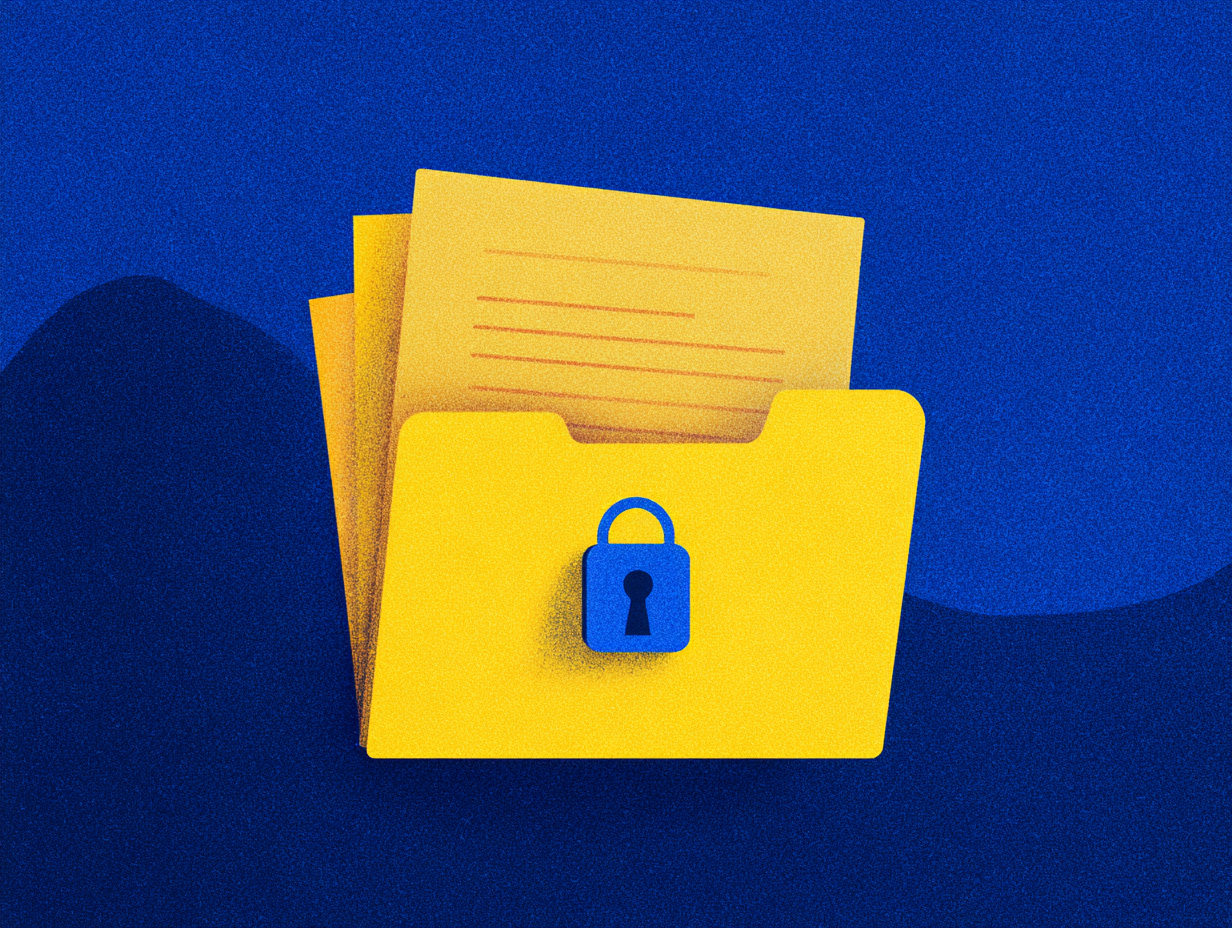
Key Factors for Ultimate Security and Privacy in Data Storage Solutions
In this blog, we debunk myths about secure data storage, explaining why end-to-end encryption isn’t enough. Your data should be encrypted on your device, with keys staying on your computer, ensuring you alone control and access your data, even if the multiple cloud provider is hacked.
What Is Secure Data Storage?
Secure data storage refers to the process of keeping digital information in a way that protects it from unauthorized access, corruption, loss, or theft. It encompasses a range of techniques and technologies designed to ensure that data remains safe, accessible only by authorized users, and intact over time.
In Six Key Steps How Cryptography Used in Secure Data Storage
Client-side encryption, secure key management, data encryption in transit, digital signatures & authentication, zero-knowledge encryption, and of course, reliable hashing—these are the pillars of robust data security.
Client-Side Data Encryption: What If Your Data Leaves Your Computer as Gibberish and Stays That Way on the Internet?
Client-side encryption is a cryptographic strategy where data is encrypted on the user's device before being uploaded to cloud storage or servers. Using algorithms like AES-256, the data is converted into unreadable ciphertext.
The encryption keys never leave the device, ensuring that only the user can decrypt and access the data.
But, you kept hearing that end-to-end encryption is enough by some vendors, right?
Well, when data is written to storage, it shouldn’t just be "encrypted using algorithms like AES (Advanced Encryption Standard), typically with 256-bit keys" by the storage provider.
The data should already be encrypted on your machine, before it even has the chance to be uploaded to someone else’s server.
The encryption keys never leave the client device, so no one else (not even the service provider) can decrypt the data.
Note that current quantum computers lack the necessary scale and error correction to pose a significant threat to AES-256. Estimates suggest that breaking AES-256 would require a quantum computer with over 6,600 logical, error-corrected qubits, a capability far beyond today's systems.
Example:
- Services like TransferChain Drive provide Client-Side E2EE, where the data is encrypted on the user’s computer before it leaves. This means that the files are essentially gibberish to anyone who doesn’t have the decryption key—including the cloud provider.
This approach eliminates the risk of unauthorized access, as even cloud providers cannot decrypt the data. It's the most secure way to ensure privacy from the moment data leaves your device.
So, next time you choose a secure data storage solution, make sure it offers client-side encryption—because anyone who wants to sleep well, knowing their data is secure, should demand it.
Key Management: Because If Nobody Has Your Key, Nobody Can Read Your Data
Key management is essential in cryptography. It involves securely generating, distributing, storing, and protecting encryption keys, which are crucial for both encrypting and decrypting data.
How it's used.
- The public key/private key mechanism is used in asymmetric encryption, where the data is encrypted with a public key and can only be decrypted using the corresponding private key.
- In symmetric encryption, a single shared key is used for both encryption and decryption. The security of symmetric encryption depends heavily on protecting the key.
Proper key management is vital for data security, ensuring only the authorized user has access to decryption keys. No matter how secure a company claims to be, even billion-dollar companies get hacked. If they have access to your keys, your data is at risk.
Example:
In TransferChain, encryption keys are generated on the client-side to ensure maximum security and privacy. Here's how the key generation process works:
The keys used for encryption are generated locally on the user's device using Elliptic Curve Cryptography (secp256k1). This ensures that only the user has access to the private key, and it never leaves their device.
Note that secp256k1 refers to the parameters of the elliptic curve used in Bitcoin's public-key cryptography, and is defined in Standards for Efficient Cryptography (SEC).
PBKDF2 (Password-Based Key Derivation Function 2) is used to securely derive keys from the user's password, ensuring that even if an attacker gains access to the device, they can't easily derive the encryption keys without the correct password.
The Diffie-Hellman (DH) key exchange protocol, specifically X3 Diffie-Hellman (X3DH), is used to securely exchange keys between the user and the recipient. The key exchange ensures forward secrecy, meaning that even if past keys are compromised, they cannot be used to decrypt future messages.
TransferChain does not store any encryption keys on its servers, ensuring that only the user can decrypt their data. The keys are securely stored on the user's device, with the decryption process occurring locally.
In short, TransferChain’s client-side encryption ensures that keys are securely generated, stored, and managed on the user’s device, giving the user complete control over their data without relying on the service provider.
Data Encryption in Transit: Locking Down Your Data While It’s on the Move
Encryption in transit is a crucial practice used to protect data while it’s being transferred between the user and the server, or between different systems, over the network.
Today, for example, the interaction between you and your bank is secured through encryption in transit, ensuring that your sensitive information—like account details and transactions—remains safe as it travels between your device and their server.
How it's used:
- TLS (Transport Layer Security) is used to encrypt data in transit. TLS ensures that all communications between your device and the server are secure and cannot be intercepted or altered by attackers during transmission.
- It prevents Man-in-the-Middle (MitM) attacks, where an attacker might intercept the data while it's being transferred.
Example in terms of secure cloud storage:
- Cloud services like Dropbox and OneDrive use TLS to encrypt files while they are being uploaded or downloaded, preventing unauthorized access during transfer.
- At the TransferChain protocol, we are using TLS (TLS 1.2 and 1.3) certificates for service connections, such as over GRPC and SSL for web applications.
Digital Signatures and Authentication: The Secret Sauce for Bulletproof Data Storage
Digital signatures are a cryptographic method used to verify the authenticity, integrity, and non-repudiation of data.
In data storage, they ensure that the data is genuine, hasn’t been altered, and that the sender is who they claim to be. They also prevent the sender from denying the authenticity of the message after it has been sent.
TransferChain ensures robust digital signatures and authentication by utilizing advanced cryptographic techniques throughout its system.
As stressed before, we are using ECC (secp256k1). This practice ensures that all data exchanges, transactions, and file transfers are properly signed, ensuring their integrity and authenticity.
The Ed25519 signature algorithm further secures the authenticity of the data, preventing tampering and ensuring the data’s origin is verified.
Our protocol manage this by using blockchain-based metadata that tracks the authenticity of the data, ensuring that only authorized users can access or interact with files. Blockchain’s inherent immutability and transparency provide a clear, auditable trail of who accessed what, when, and how, adding an extra layer of security to data and user actions.
Blockchain technology is utilized to store metadata about data ownership, authentication, and authorization processes. This decentralized approach ensures there is no centralized point of failure, and TransferChain doesn't have access to your data. It also guarantees that authentication data is secure and resistant to modification, keeping your data and its interactions safe from external threats.
Zero-Knowledge Encryption: Your Data, Your Key, No One Else’s Business
Zero-knowledge encryption is a method where the service provider cannot access the user's data, even though the data is stored on the provider's infrastructure.
The service provider (the person holding the box) can store the box safely and keep it protected, but they cannot see inside because they don’t have the key.
Only you, the person who owns the box, have the key to open it and access its contents.
How it's used:
- The data is encrypted on the user’s side before being uploaded to the cloud, and only the user holds the decryption key. The provider cannot decrypt or view the data because they don’t have the keys.
- The concept of Zero-Knowledge Proofs (ZKPs) is often employed to prove something about the data without revealing the data itself.
Example:
TransferChain provides zero-knowledge encryption across all platforms, including web browsers. Files, encryption keys, and user passwords are never transmitted or stored in an unhashed or unencrypted format, nor visible to servers or TransferChain administrators.
In other words, there is complete privacy between you and your recipient.
Data Integrity and Hashing
Hashing is a cryptographic process used to verify the integrity of data. A hash is a fixed-size string generated by a cryptographic hash function, and it’s uniquely tied to the original data.
This process is deterministic, meaning the same input will always produce the same output. But here’s the kicker: even if one single bit of the data changes, the entire output will be completely different.
This makes hashing a perfect way to ensure that data hasn’t been altered—any change, no matter how small, will completely alter the hash and indicate tampering.
How it's used:
- Hashing is used to ensure that data hasn’t been altered. When data is stored, its hash is also stored, and when accessed or transferred, the hash is recalculated and compared to the original hash to verify data integrity.
- If the hashes match, the data is intact; if they don't, the data has been altered.
Example:
In TransferChain, hashing is primarily used for data integrity verification and secure address generation.
Here's how we utilize hashing.
TransferChain uses SHA-512 to generate unique addresses for user transactions and file metadata. The SHA-512 hash algorithm creates a 512-bit hash that ensures forward secrecy by generating a random 32-byte public key for each transaction.
This makes sure that previous addresses cannot be traced or compromised, even if private keys are exposed.
We also use hashing to ensure that the data being stored has not been altered. During file transfers or storage, hashing helps in verifying the integrity of the data. If a file is tampered with, the hash would change, and the system would detect it immediately, making the file unreadable or invalid.
Hashing is also employed in the blockchain used by TransferChain. All encrypted metadata regarding data ownership, access, and transactions is hashed and stored on the blockchain, making it immutable and indelible. This ensures that even if data is accessed or moved across providers, the original file's integrity can be easily verified, and unauthorized changes are prevented.
In summary, TransferChain leverages SHA-512 hashing for both secure address generation and integrity verification, ensuring that all data stored and transferred remains unaltered and authentic while keeping metadata secure on the blockchain.
What to Avoid When Choosing a Secure Data Storage Solution?
Server-Side Only Encryption:
Ensure client-side encryption, data should be encrypted on your device before reaching the cloud.
Provider-Controlled Keys:
Always manage your own encryption keys. Never let the provider have access to them.
Weak Encryption Algorithms:
Look for strong encryption, like AES-256 and Elliptic Curve Cryptography.
No Forward Secrecy:
Ensure the system uses forward secrecy to protect future data, even if keys are compromised.
No Zero-Knowledge Encryption:
Your provider should never be able to access your files, zero-knowledge encryption is a must.
Ignoring Data Integrity:
Ensure hashing is used to detect tampering with stored data.
By avoiding these pitfalls, you can ensure your data remains secure and under your control.
TransferChain Protocol: The Wildest, Most Secure Data Storage Solution
TransferChain doesn’t just talk about secure data storage, it delivers.
Using AES-256 encryption and Elliptic Curve Cryptography (secp256k1), we provide robust protection for your data.
TransferChain keeps your files secure, under your control, and private, no one else gets access, no matter what happens to the cloud provider.


